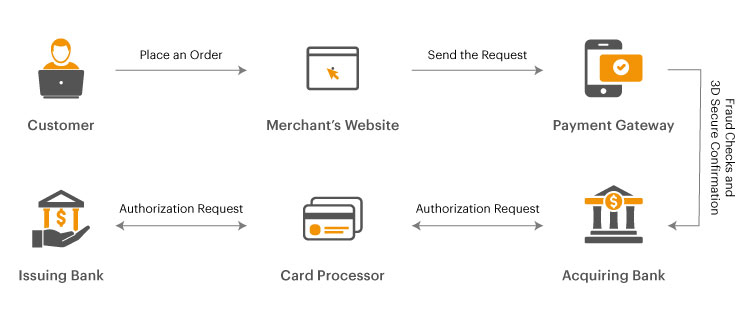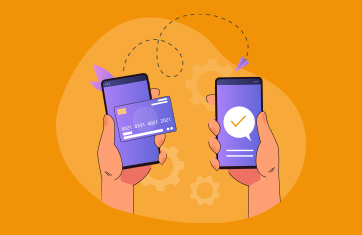What is a Payment Gateway?
A payment gateway is a technology that facilitates online transactions by acting as an intermediary between an online merchant, a customer, and the financial institutions involved in the transaction. It enables secure and seamless transfer of funds from the customer's payment source (such as a credit card, debit card, or digital wallet) to the merchant's account.
A payment gateway is the third-party software service that securely sends payment information (such as credit card details) from the checkout page of a website to the credit card payment networks for processing and returns the response from the payment networks back to the website.
Payment gateways come with an array of benefits:
- They support different payment modes such as debit cards, online banking accounts, or online wallets. They also support multi-country, multi-language, multi-currency, and multi-time-zone processing.
- They make it easy for you to be PCI-DSS compliant. The customer’s bank or card details are stored in the payment gateway’s infrastructure – not yours.
- They provide fraud screening tools to reduce the risk of fraudulent transactions.
How does a Payment Gateway work?
A payment gateway typically works, thus:
- Customer Initiates Payment: When a customer makes a purchase on an e-commerce website or any online platform, they proceed to the checkout page and select their preferred payment method.
- Payment Information: The customer enters their payment information, which could include credit card details, debit card details, or other forms of digital payment.
- Encryption: The payment gateway encrypts the customer's payment information to ensure its security during transmission over the internet. This encryption helps protect the sensitive data from being intercepted by malicious actors.
- Transaction Routing: The encrypted payment information is then sent to the payment gateway's server, where it is decrypted and processed. The payment gateway routes the transaction to the appropriate financial institution, which could be the customer's bank or the institution that issued their credit/debit card.
- Authorization: The financial institution receives the transaction request, verifies the customer's payment information, and checks for available funds. If everything is in order, the institution sends an authorization code back to the payment gateway.
- Merchant Notification: The payment gateway receives the authorization code and informs the merchant that the payment has been approved. This allows the merchant to proceed with fulfilling the customer's order.
- Transaction Settlement: At the end of the day or a specific settlement period, the payment gateway consolidates all approved transactions and sends a request to the acquiring bank (the bank that processes payments on behalf of the merchant) to transfer the funds from the customer's account to the merchant's account.
- Funds Transfer: The acquiring bank transfers the funds to the merchant's bank account, minus any applicable fees or charges.

What are popular payment gateway options?
Popular, well-known payment gateways include: PayPal, Stripe, Square, Authorize.Net, Apple Pay, Adyen, 2Checkout (now Verifone), Amazon Pay and Worldpay. There are many other payment gateway providers globally, see: List of online payment service providers - Wikipedia.
Consequences of Payment Gateway failure
If a payment gateway fails, it can have various implications for both the customer and the merchant. The consequences of a payment gateway failure can include:
- Transaction Disruptions: A payment gateway failure can result in transactions not being processed successfully. Customers may encounter errors during the payment process, leading to incomplete purchases.
- Lost Revenue: Failed transactions can directly impact revenue, as customers might abandon their purchases due to frustration or uncertainty about whether their payment went through.
- Customer Frustration: Customers who experience payment gateway failures may become frustrated with the shopping experience and may perceive the business as unreliable.
- Reputation Impact: Consistent payment gateway failures can damage the reputation of the business. Customers might lose trust in the company's ability to provide a seamless online shopping experience. Customers might vent their anger on social media.
- Operational Disruptions: Payment failures can disrupt order processing and fulfillment, potentially causing delays in delivering products or services to customers. Customers who are unable to complete their transactions may flood your contact center.
Beyond absolute failures, payment gateway performance issues can also have an impact on customers and a business. Slow websites and payment processing deters customers and leads to abandoned shopping karts.
Monitoring Payment Gateways is important
Site reliability engineering (SRE) teams must have visibility on error rates and response times across all payment gateways. They need to rapidly identify slowness or failure with any individual payment gateway and inform their customers proactively. It is also key for SRE teams to inform management of the business impacts including the cost of lost sales and which users were impacted so follow-up mitigation steps can be actioned.
A good monitoring tool should be able to answer key questions for SRE teams, such as:
Service-level quality questions:
- Availability: Is the payment gateway up and running?
- Functionality: Is the checkout and payments functionality working right? Are there any errors?
- Speed: Is the payment gateway responding fast enough?
Other Questions
- Can we get proactive, real-time alert notifications when a payment gateway is down?
- Can we triage payment errors or slowdowns by their impact on revenue?
- Based on the payment gateway health, can we enable or disable different payment gateways to circumvent issues?
- Can we pinpoint payment gateway issues to geographically local issues?
- Can we identify impacted users for retargeting purposes (give them offers/coupons to mitigate their frustration)?
- Can we assess the effects of IT changes in pre-production and test systems before they are released to production systems where real users may be affected?
For more information on monitoring eCommerce apps and payment gateways, see: E-Commerce Monitoring for Applications and Payment Gateways.


